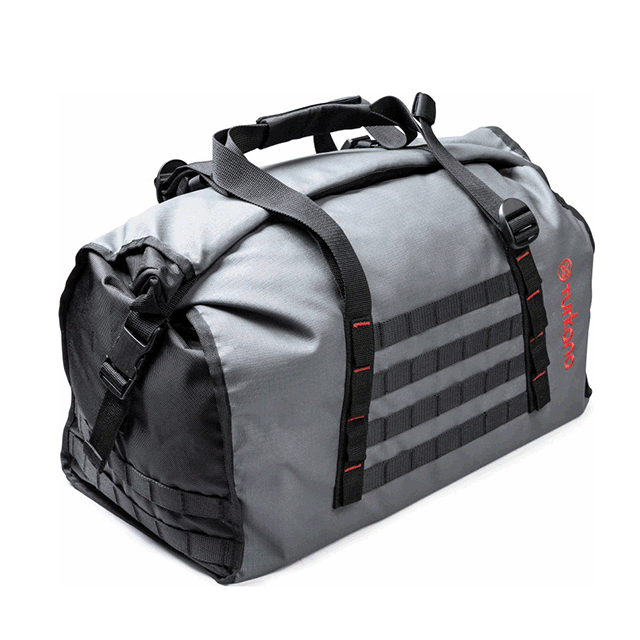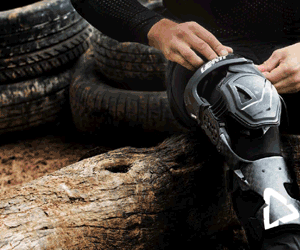“In the far north of British Columbia, I rode over 125 mi / 200 km into the wilderness on an abandoned rail grade. Being that deep into the north on my own was a fabulous experience. One morning while I was waking up, I heard the noise of animals running past my tent. I waited a few moments until I thought they had moved on and then crawled out of the tent to check out what it had been. As I inched over a low mound in front of my tent, I saw a moose cow and her yearling calf a few meters away munching on willows. It was a special moment seeing them so deep in the wilderness framed by the snow-covered peaks behind them.” – Trent Schumann

Trent hails from Calgary in Alberta, Canada. “I started riding when I was about ten years old. A friend that lived ten miles down the highway had a little Briggs & Stratton powered mini bike. I would regularly make the trek to his house on my bicycle, and we would spend the day riding around in the woods. My first real motorcycle, however, was a 1976 Harley branded 125cc two-stroke made by Cagiva. I rode that thing for about four years before the motor packed it in and I went off to university.”

“After leaving for university I left motorcycling behind for many years, opting for self-propelled activities such as hiking, backpacking, mountain biking, ski touring, kayaking and so on. Then on a trip to Thailand in 2004, I decided to rent a Honda XR250L for a week and rode around in the mountains of Northern Thailand. I was hooked again. So the first thing I did when I got home was to buy a Honda XR250R. Since then I’ve been riding as much as possible, come winter or summer. I do most of my riding in the mountains of British Columbia and Alberta in Western Canada, and it mostly consists of off-road riding.”

It was during these extended rides in the wilderness that Trent came up with the idea for this current project called Wanduro. “My original concept was simply a YouTube channel and website where I could share rides and information. Shortly after that, my friend Daan joined me, and we started to think bigger. Now Wanduro creates the WANDR adventure Moto navigation events. We host an online community and still create content for the Wanduro YouTube channel and Wanduro website. Our 2018 WANDR event attracted a hundred and forty riders and judging by the feedback; it was a roaring success. As of now, there are already over seventy people signed up for WANDR 2019 that will be taking place this coming August.”

Trent’s current weapon of choice for backcountry exploration is a 2013 Honda CRF450X. “I bought it from a fellow that had set it up for Baja racing but then decided to sell it. It had less than one hour on it when I bought it. It matched my needs, and it was a good deal. The previous owner had already added a Sicass Racing dual sport kit to it and gotten it registered for on-road use. The XR250R that I was riding previously was a great trail bike, but I was ready for something with more power and excitement as well as modern suspension. It’s a proven platform with repeated wins at Baja attesting to its reliability. That, and I just like Hondas.” The list of upgrades is also a rather extensive list that touches all aspects of the machine. Air filtration is handled by a Twin Air Powerflow air filter along with a cutaway modification to the air-box. For fuel range, Trent fitted a 4.1 gal / 15.5 L Acerbis tank, although he also has a 6.6 gal / 25 L Acerbis tank along with a 3.2 gal / 12 L IMS tank for different fuel configurations. Up front rides a Scott steering stabilizer with sub-mount, Acerbis bark busters, TrailTech Endurance computer, a Billet perch-mount start/kill switch along with a 12V power point for GPS and other accessories. The electrics have been upgraded with a Ricky 110 watt stator, and a radiator fan keeps things cool.

All the plastics have been replaced with black aftermarket plastics to save the stock plastics and change the look along with the aftermarket black seat cover. A Flatland Racing skid plate protects from strikes along with a clutch case saver and chain case guard. The suspension has seen a Motion Pro front fork valves upgrade while the footpegs have been switched out for a set of Moose Racing extra wide pegs. The carb has been treated to a JD carb jetting kit while the exhaust is now an MRD Racing exhaust. “The rear is a customized DIY license plate holder and tail-light arrangement designed not to break in a fall. There’s also a DIY map pocket behind headlight cowl. The CRF also has a fairly aggressive maintenance schedule. In competition use it is recommended that you change the engine oil, transmission oil along with the piston and rings every sixteen hours! Thankfully, the maintenance schedule for general use is nowhere near that bad. In fact, it doesn’t even mention changing the piston. Another solution is also to replace the stock piston with a Honda TRX450 Quad piston which has an extra ring and a slightly wider skirt.” With all these modifications Trent reports that; “It’s a super fun ride with tons of power whenever needed. It’s not necessarily as smooth as the equivalent KTMs I’ve ridden, so you really need to pay attention, so you don’t launch yourself over a cliff!”

“I use both GPS and maps. I have an old-school Garmin 60csx that is my backup navigation device and is loaded with maps from Backroad Mapbooks. These are detailed Garmin compatible maps that cover the majority of the roads and trails in Western Canada. I also have a smartphone with the OruxMaps app loaded. This app reads Garmin files, and I also have the Backroad Mapbooks maps loaded on there. So for most of my navigation, I use the smartphone. I also print off pages that cover the area I’ll be riding in. For this, I use waterproof Tyvek paper. These pages are much better than using a GPS or smartphone since it gives an overview of the area and makes planning your next move much easier.”

“I used to use Kenda K760 Trakmaster II tires front and rear. Basically, because they were cheap, decent and wore out ok, but then I started hearing about people using trials tires on the back. So I went for a Pirelli MT43 trial tire. It was wonderful for a single tight track but a bit wobbly and mushy for the gravel roads. After I wore that out, I tried the Shinko Trail Pro 255 trials tire. It was terrific on single track but abysmal on gravel and pavement. The sidewalls were just too soft for lateral stability in corners. My latest choice is the Kenda Trakmaster on the front and a MOTOZ Mountain X Hybrid on the back. I think the MOTOZ will be my go-to tire from now on for my type of riding. Fantastic grip in the single tracks, rocks, and roots. Surprisingly good in mud. Handles well on gravel and pavement plus its outlasted any other off road tire I’ve tried.”

“For day rides I use a backcountry ski touring backpack. It is designed to hug your body and minimize the effects on your balance. This makes it ideal for technical off-road riding. It’s also a fair bit cheaper than similar motorcycle-specific backpacks. For day rides, I prefer to carry everything in the backpack, even if it gets a bit on the heavy side, rather than attaching things to my bike. Additional luggage added to the bike negatively affects the handling, more easily gets hooked by branches and makes it much harder to pick up, push and lift the bike through difficult areas.”

For Trent, there is no single key to successful navigation riding in remote locations. “It’s a combination of things. You need to be comfortable and competent in the backcountry. Navigation, map reading, and GPS skills are key to achieving that. Then, you need to be prepared for what lays ahead. Google Earth is a great tool for getting the lay of the land and understanding the terrain you will be riding. Off course you’ll need a well-maintained and reliable motorcycle. You also need to know how to fix or maintain that motorcycle and have the required tools along to do it. Lastly, I’d say being prepared for and good at handling emergencies is a definite must for when things do go wrong.”

Ironically though, with all these backcountry excursions one of the best experiences Trent has had riding thus far ended up being outside of his native Canada; “A local friend that I was traveling with managed to arrange a visit to an indigenous community in the Sierra Nevada de Santa Marta range in the northern part of Columbia. This community normally doesn’t welcome outsiders, but she was friends with one of its members. After an initial couple of days at their remote village, we were invited to meet with their spiritual leader so that we could get permission to capture some photos and video. We spent about two hours with him while our friend translated for us. The next day the spiritual leader invited us back to let us know that after deliberations he’d decided to give us a ‘seguranca’ or ‘safety’ which was his blessing and permission to participate in and document village life. He gave us each a small band of cotton that he tied around our wrists to indicate that we had passed his scrutiny. That moment when he tied the band around each of our wrists was a special moment and led to some amazing experiences within the community.”
For more on Trent’s adventures follow along on the Wanduro Life Instagram page.





Leave a Reply